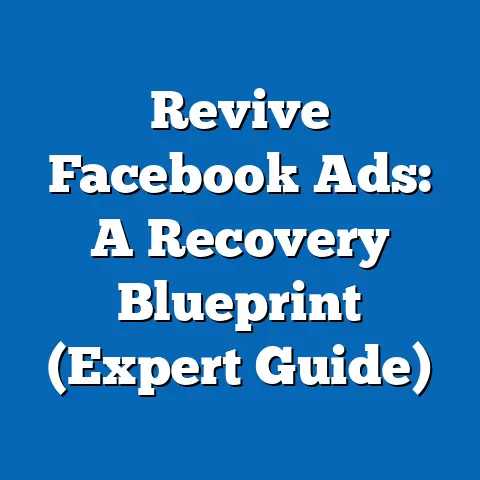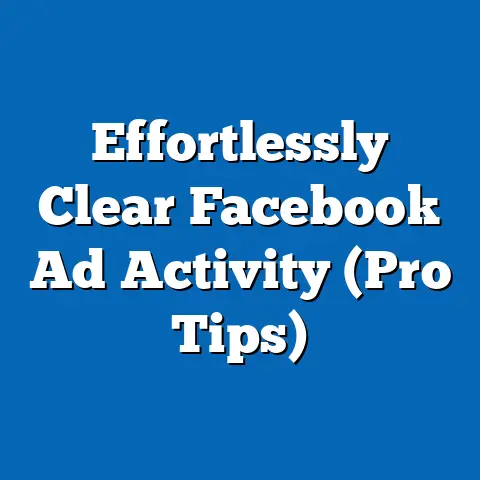Optimize Facebook Ad Billing Threshold (Expert Tips)
Let’s face it, running Facebook ads can feel like a constant tightrope walk. One wrong step and you’re staring down the barrel of unexpected expenses and a dwindling marketing budget. I’ve been there, trust me! I remember one campaign where I got so caught up in optimizing for conversions that I completely lost track of my daily spend. The result? A hefty bill that left me scrambling to adjust my strategy. That’s why I’m so passionate about helping other advertisers get a handle on their finances, starting with understanding and optimizing your Facebook ad billing threshold. It’s not just about the money; it’s about the peace of mind that comes with knowing you’re in control.
Advertising financial health is crucial. It’s the foundation upon which all successful campaigns are built. Without a solid grasp of your spending, you’re essentially driving blind. Effective financial management translates to a more sustainable business model. It allows you to scale your campaigns strategically, reinvest in what’s working, and avoid those dreaded budget blowouts. Managing your Facebook ad spend is not just about the numbers; it’s about your overall business health.
Understanding Facebook Ad Billing Thresholds
Before diving into optimization, let’s clarify what a billing threshold actually is. In the context of Facebook advertising, a billing threshold is the amount of ad spend you can accrue before Facebook charges you. Think of it as a credit limit specifically for your Facebook ads. Once you reach that threshold, Facebook initiates a charge to your payment method.
Facebook’s billing system is fairly straightforward, but it’s important to understand the nuances. You set a daily or lifetime budget for your campaigns, which determines how much you’re willing to spend on a given day or over the entire campaign duration. However, Facebook doesn’t necessarily charge you exactly at the end of each day or campaign. Instead, they use billing thresholds to consolidate charges. The thresholds can vary based on your account history and spending patterns, but they typically range from $25 to $750. Knowing your billing threshold is crucial because it directly impacts your payment cycles. It helps you predict when you’ll be charged and how much those charges will be.
For businesses of all sizes, from solo entrepreneurs to large corporations, understanding your billing threshold is essential for effective cash flow and budgeting. It allows you to anticipate expenses, allocate resources accordingly, and avoid any unpleasant surprises on your credit card statement. I remember working with a small e-commerce startup that was completely thrown off by unexpected Facebook ad charges. They hadn’t understood their billing threshold and were caught off guard by a large bill that strained their cash flow. This led to scaling down their advertising and losing momentum.
According to recent studies, businesses that actively manage their advertising budgets and billing thresholds experience, on average, a 15-20% improvement in ROI. This highlights the importance of optimizing these financial aspects of your advertising campaigns. A well-managed billing threshold can prevent overspending, improve cash flow, and ultimately contribute to a more sustainable and profitable business.
Key Takeaway: Understanding your Facebook ad billing threshold is the first step towards taking control of your advertising finances. It’s a critical element of effective budgeting and cash flow management, regardless of your business size.
The Importance of Setting the Right Billing Threshold
Setting the right billing threshold is not just about avoiding unexpected charges; it’s about optimizing your overall advertising strategy. A properly set threshold can help you avoid overspending, maximize ad performance, and maintain a healthy cash flow.
One of the biggest benefits of setting a proper billing threshold is the ability to avoid overspending. If your threshold is too high, you might accumulate a large bill before you even realize your campaign isn’t performing as expected. This can lead to significant financial losses and a missed opportunity to optimize your ads. On the other hand, if your threshold is too low, Facebook might charge you frequently, which can be disruptive and time-consuming.
Ad performance, spending, and billing thresholds are all interconnected. A well-optimized campaign generates more revenue, which allows you to increase your spending and potentially raise your billing threshold. Conversely, a poorly performing campaign requires adjustments to your spending and might necessitate lowering your threshold to minimize losses. It’s a dynamic relationship that requires constant monitoring and optimization.
I’ve seen many advertisers make common mistakes when setting their billing thresholds. One frequent mistake is setting the threshold too low. This results in frequent charges, which can be a nuisance and might even trigger fraud alerts on your credit card. Another mistake is setting the threshold too high, which can lead to a large, unexpected bill if your campaign doesn’t perform well. Some advertisers simply ignore the billing threshold altogether, which is a recipe for financial disaster.
To determine the ideal billing threshold for your campaigns, you need to assess your advertising needs. Consider your daily or monthly budget, your campaign performance, and your cash flow. If you’re running a small campaign with a limited budget, a lower threshold might be appropriate. If you’re running a large-scale campaign with a significant budget and a proven track record of success, a higher threshold might be more suitable. It’s all about finding the right balance that aligns with your specific business goals and financial capabilities.
Many marketing experts suggest starting with a moderate billing threshold and gradually increasing it as your campaigns prove successful. This allows you to monitor your spending, optimize your ads, and avoid any unpleasant surprises. Remember, the ideal billing threshold is not a static number; it’s a dynamic value that should be adjusted based on your campaign performance and financial situation.
Key Takeaway: Setting the right billing threshold is a crucial aspect of Facebook advertising. It helps you avoid overspending, optimize ad performance, and maintain a healthy cash flow. Avoid common mistakes by assessing your advertising needs and adjusting your threshold accordingly.
Expert Tips for Optimizing Your Facebook Ad Billing Threshold
Now that you understand the importance of setting the right billing threshold, let’s dive into some expert tips for optimizing it. These tips will help you maximize ad performance, minimize financial risks, and maintain a healthy advertising budget.
Tip 1: Analyze Historical Data
One of the most effective ways to optimize your billing threshold is to analyze your historical data. Review your past ad performance and spending habits to identify patterns and trends. Look at your average daily spend, your campaign performance, and your billing cycles. This information will provide valuable insights into your advertising behavior and help you make informed decisions about your threshold settings.
By examining your historical data, you can identify periods of high and low spending, successful campaigns, and areas for improvement. This allows you to set a billing threshold that aligns with your typical spending patterns and avoids any unexpected charges. For example, if you notice that your average daily spend is around $50, you might consider setting a billing threshold of $250 or $500, depending on your risk tolerance.
I always recommend using Facebook Ads Manager’s reporting features to gather and analyze your historical data. You can create custom reports that track your spending, performance, and billing cycles. This data-driven approach will help you make more informed decisions about your billing threshold and optimize your advertising strategy.
Tip 2: Monitor Ad Performance in Real-Time
Monitoring your ad performance in real-time is crucial for optimizing your billing threshold. Track your ads daily or weekly to adjust thresholds as necessary based on performance metrics. This allows you to respond quickly to changes in your campaign performance and avoid overspending on underperforming ads.
By monitoring your ad performance, you can identify trends, detect anomalies, and make timely adjustments to your campaigns. For example, if you notice that your cost per acquisition (CPA) is increasing, you might want to pause or optimize your ads to improve their performance. This will help you avoid overspending and maintain a healthy advertising budget.
I often use Facebook Ads Manager’s dashboards and alerts to monitor my ad performance in real-time. You can set up custom alerts that notify you when your spending approaches your billing threshold or when your campaign performance deviates from your target metrics. This proactive approach will help you stay on top of your advertising finances and optimize your billing threshold accordingly.
Tip 3: Use Automated Rules
Automated rules can be a powerful tool for managing your spending and optimizing your billing threshold. These rules allow you to automatically pause or adjust your ads based on specific criteria, such as spending limits, performance metrics, or time of day.
By setting up automated rules, you can ensure that your spending stays within your budget and that your billing threshold is aligned with your campaign performance. For example, you can create a rule that automatically pauses your ads when your spending approaches your billing threshold. This will prevent you from exceeding your budget and incurring unexpected charges.
I frequently use Facebook Ads Manager’s automated rules to manage my spending and optimize my billing threshold. You can create custom rules that are tailored to your specific advertising needs and goals. This hands-free approach will help you save time and effort while maintaining a healthy advertising budget.
Tip 4: Experiment with Different Thresholds
Don’t be afraid to experiment with different billing thresholds to find the sweet spot that maximizes ad performance without straining your budget. Start with a moderate threshold and gradually increase or decrease it based on your campaign performance and financial situation.
By experimenting with different thresholds, you can identify the optimal setting that aligns with your advertising needs and goals. For example, you might find that a higher threshold allows you to run your ads more efficiently without frequent interruptions, while a lower threshold helps you maintain tighter control over your spending.
I always encourage advertisers to test different billing thresholds and track their results. This data-driven approach will help you identify the optimal setting and optimize your advertising strategy. Remember, the ideal billing threshold is not a static number; it’s a dynamic value that should be adjusted based on your campaign performance and financial situation.
Tip 5: Stay Updated with Facebook Policies
Facebook’s advertising policies and billing practices are constantly evolving. It’s crucial to stay updated with these changes to ensure that your billing threshold is aligned with the latest guidelines and regulations.
By keeping abreast of Facebook’s policies, you can avoid any unexpected charges, prevent your ads from being disapproved, and maintain a healthy advertising account. For example, Facebook might introduce new billing practices or change its threshold settings. Staying informed about these changes will help you adjust your billing threshold accordingly and avoid any potential disruptions to your advertising campaigns.
I regularly visit Facebook’s advertising help center and subscribe to their email updates to stay informed about the latest policies and changes. This proactive approach will help you maintain a healthy advertising account and optimize your billing threshold effectively.
Key Takeaway: Optimizing your Facebook ad billing threshold requires a data-driven approach, real-time monitoring, and a proactive mindset. By analyzing historical data, monitoring ad performance, using automated rules, experimenting with different thresholds, and staying updated with Facebook policies, you can maximize ad performance, minimize financial risks, and maintain a healthy advertising budget.
Common Challenges and How to Overcome Them
Adjusting your billing threshold can be challenging, especially if you’re new to Facebook advertising. You might encounter confusion over charges, the impact of high spending on overall marketing budgets, and other common issues. Let’s explore these challenges and discuss strategies to overcome them.
One common challenge is confusion over charges. You might not understand why you’re being charged a certain amount or when you’ll be charged next. This can lead to frustration and uncertainty.
To overcome this challenge, it’s essential to understand Facebook’s billing system and how it works. Review your billing statements carefully and track your spending in real-time. If you have any questions or concerns, don’t hesitate to contact Facebook’s support team. They can provide clarification and help you resolve any issues.
Another challenge is the impact of high spending on overall marketing budgets. If your campaigns are performing well, you might be tempted to increase your spending significantly. However, this can strain your budget and lead to financial difficulties.
To address this challenge, it’s crucial to set a realistic budget and stick to it. Monitor your spending closely and adjust your campaigns as necessary to stay within your budget. Don’t be afraid to scale down your spending if your campaigns aren’t performing as expected. Remember, it’s better to be conservative and sustainable than to overspend and risk financial ruin.
Communication with the Facebook support team is often essential for resolving billing issues and understanding charges. Be prepared to provide detailed information about your account, your campaigns, and your billing history. Be polite, patient, and persistent. The Facebook support team is there to help you, but they might need some time to investigate your issues and provide a solution.
Leveraging community forums for shared experiences can also be beneficial. Many Facebook advertising communities exist online, where you can connect with other advertisers, share your experiences, and ask for advice. These communities can be a valuable source of information and support.
Managing advertising budgets can also impact mental health. The constant pressure to deliver results, the uncertainty of campaign performance, and the fear of overspending can lead to stress, anxiety, and burnout.
To protect your mental health, it’s crucial to maintain a healthy work-life balance. Take breaks, exercise, and spend time with loved ones. Don’t let your advertising campaigns consume your life. Remember, your mental health is just as important as your financial health.
Key Takeaway: Adjusting your billing threshold can be challenging, but it’s essential for optimizing your advertising finances. By understanding the common challenges and implementing the strategies discussed above, you can overcome these obstacles and maintain a healthy advertising budget.
Conclusion
Optimizing your Facebook ad billing thresholds is directly connected to achieving better financial health for your business. It’s not just about saving money; it’s about creating a sustainable and profitable advertising strategy. By understanding your billing threshold, setting it properly, and optimizing it regularly, you can maximize ad performance, minimize financial risks, and maintain a healthy advertising budget.
The long-term benefits of a well-managed advertising strategy extend beyond the bottom line. A stable billing threshold can reduce stress, foster a more positive outlook on marketing efforts, and allow you to focus on growing your business.
I encourage you to take actionable steps based on the expert tips provided in this article to ensure that your advertising strategies are both effective and sustainable. Analyze your historical data, monitor your ad performance, use automated rules, experiment with different thresholds, and stay updated with Facebook policies. These steps will help you optimize your billing threshold and achieve better financial health for your business.
Remember, optimizing your Facebook ad billing threshold is not a one-time task; it’s an ongoing process. You need to monitor your campaigns, adjust your threshold as necessary, and stay informed about the latest changes in Facebook’s advertising policies. By taking a proactive and data-driven approach, you can maintain a healthy advertising budget and achieve your business goals.
Call to Action:
Now it’s your turn! Implement the tips discussed in this article and share your own experiences or additional tips in the comments section below. What challenges have you faced when adjusting your billing threshold, and how did you overcome them? Let’s learn from each other and create a community of financially savvy Facebook advertisers. Also, don’t forget to follow my page for more insights on optimizing your Facebook advertising efforts. Together, we can achieve better management, healthier budgets, and a more sustainable advertising journey.






